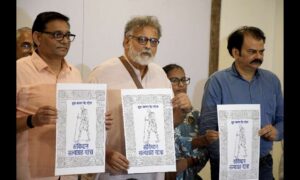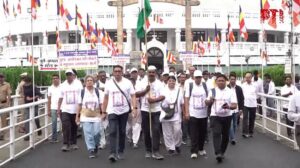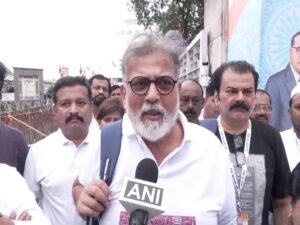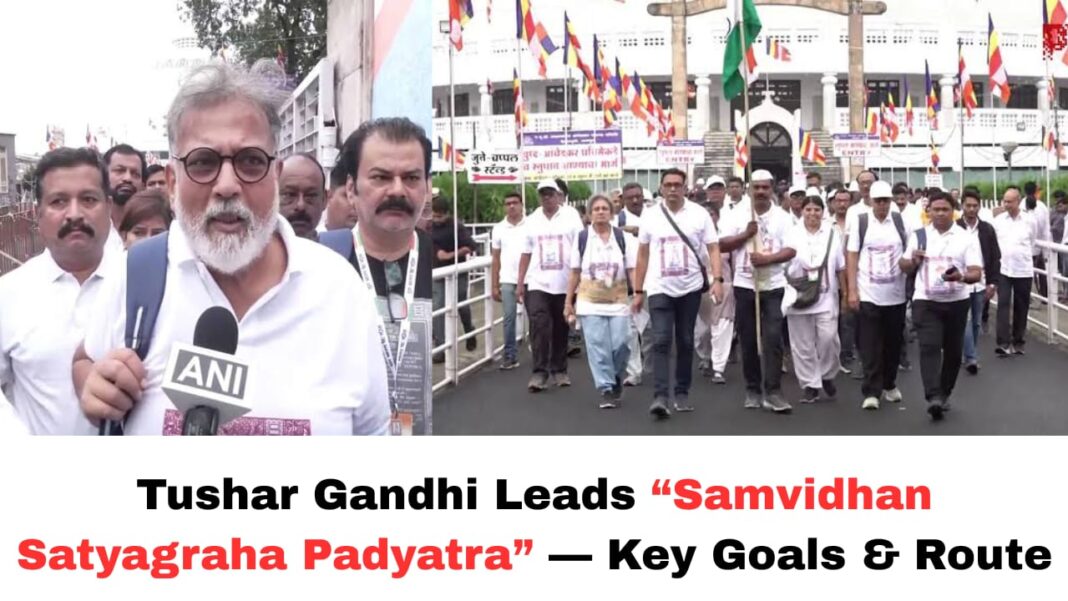Digital News Guru Maharashtra Desk:
Tushar Gandhi (great-grandson of Mahatma Gandhi) Is Leading The Padyatra
On 29 September 2025, a new chapter in India’s democratic discourse began as the Constitution Satyagraha Padyatra — also called “Samvidhan Satyagraha Padyatra” — was inaugurated from Deekshabhoomi, Nagpur, with its terminus set for Sevagram Ashram, Wardha, on 2 October (Gandhi Jayanti). The four-day march is being staged under the banner of Hum Bharat Ke Log, with great-grandson of Mahatma Gandhi, Tushar Gandhi, leading the effort.

Origins, Goals & Symbolism
The Padyatra is grounded in a deep symbolism. Deekshabhoomi, the site from which the march begins, is intimately associated with Dr. B. R. Ambedkar and the mass conversion of Dalits to Buddhism, thus evoking themes of social justice, equality, and constitutional dignity. Sevagram, where the march concludes, is tied to Gandhian legacy and his ashram operations. The march’s timing — ending on Gandhi Jayanti — intentionally overlaps with the Rashtriya Swayamsevak Sangh’s (RSS) centenary celebrations in Nagpur, giving it both symbolic and political resonance.
Organizers say that the march is not merely a protest, but a people’s movement aimed at reviving and defending the core tenets of India’s Constitution — equality, fraternity, justice, secularism, nonviolence — while combating what they describe as growing “politics of hate” and intolerance.
The framing underscores a sense that constitutional values are under strain — that individuals and institutions must actively insist on them, rather than passively assume their protection.
The March: Scale, Route & Participation
The Padyatra spans about 90-91 km over four days, from September 29 to October 2. Along the way, the marchers will pause in places such as Butibori, Khadki, Nalwadi, among others, to hold public meetings, discussions on constitutional values, cultural programmes, and interaction with local communities. The final public congregation is scheduled on 2 October at Sevagram.
A select group of 75 participants from across ideological lines (Gandhian, Ambedkarite and allied viewpoints) will walk the full route. In addition, several civil society and social organizations from states such as Assam, Manipur, and Ladakh have expressed interest in joining or supporting the effort.
From the political side, Harshvardhan Sapkal, president of Maharashtra’s Congress unit, is actively participating in or endorsing the Padyatra. He has stated that the march challenges what he calls the “divisive foundations laid by the RSS concerning untouchability and discrimination.”

Tushar Gandhi, in lead remarks, has declared that this march is being done “to strengthen and protect the Constitution” and to “counter the hatred spread by Sangh Parivar and affiliates.” In past days, a torch march was held in Nagpur to build momentum.
Political Context & Implications
The Padyatra is unfolding at a politically charged moment. On October 2, alongside Gandhi Jayanti, the RSS is conducting its centenary celebrations in Nagpur — making the concurrent march a sharp counterpoint in the narrative space. Observers expect a symbolic tussle over ideology, legacy, and public sentiment in the region, especially as both events converge spatially and temporally.
Many see the march as an assertion of civil society’s right to dissent, to protest, and to claim agency in defining the contours of public discourse. By walking through towns and villages, the participants hope to reclaim constitutional language from being abstract or rhetorical, and instead ground it in lived conversations.
However, the alignment of this march with opposition or non-BJP political voices raises doubts in some quarters about whether it will be perceived as partisan. Some critics may argue that constitutional activism becomes politicized when intersecting with ongoing electoral or ideological competition.
Still, the organizers frame their effort consciously as nonpartisan — a moral call to all citizens, irrespective of party, to own the Constitution and protect it from erosion.
Challenges & Prospects
Logistics & Security
Managing a multi-day foot march across changing terrain, coordinating halts, public programmes, transport of participants, and ensuring safety and efficient movement will test organizational capacity. In politically sensitive areas, ensuring peaceful interactions with local administration, avoiding disruptions, and managing crowd control will be critical.
Message & Media
To gain traction beyond regional reportage, the march must capture media attention with compelling narratives and visible public engagement. It will also need to navigate potential pushback, media framing, or attempts at delegitimization. The linkage to Gandhian legacy, constitutional values, and public rights gives some symbolic weight, but sustaining resonance over multiple days is a challenge.

Sustainability & Follow-up
One question is whether the Padyatra will be a one-off spectacle or the start of a sustained campaign. For lasting impact, it would need to translate symbolism into concrete local actions — community dialogues, education campaigns, litigation, policy advocacy, institutional monitoring, and networks that continue even after October 2.
Symbolic Clashes & Interpretations
Because the RSS centenary celebration overlaps, every step of the march will be observed under a political magnifier. Symbolic gestures, slogans, route decisions, participation patterns — all will be interpreted. The tension is already present in how organizers frame their march “against hatred politics” and aim to reclaim constitutional priorities. Whether they succeed in maintaining narrative control or get framed as partisan will matter.
Samvidhan Satyagraha Padyatra — What It Means for India Today
The Constitution Satyagraha Padyatra is a bold attempt to bring constitutional values into the public square through the old mode of walking, speaking, engaging — reminiscent of freedom-movement traditions. In a time when political polarization and identity narratives are contested, the march seeks to remind citizens that the Constitution is not a relic, but a living framework that requires active guardianship.
Its success will not be measured merely in kilometers walked, or speeches delivered, but in whether it spurs sustained action, deepens democratic culture, and bridges the gap between constitutional ideals and public life. The coming days will be a test — of stamina, of coherence, and of the capacity of civil society to reclaim moral space in India’s political discourse.
You May Also Read: First India-Born Cheetah Mukhi Reaches Adulthood at Kuno National Park








